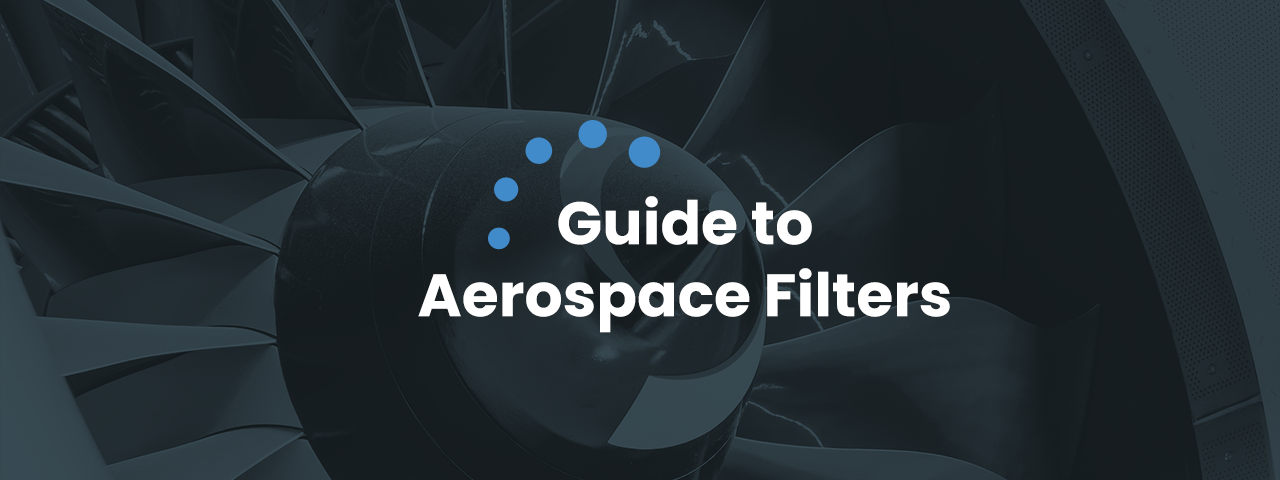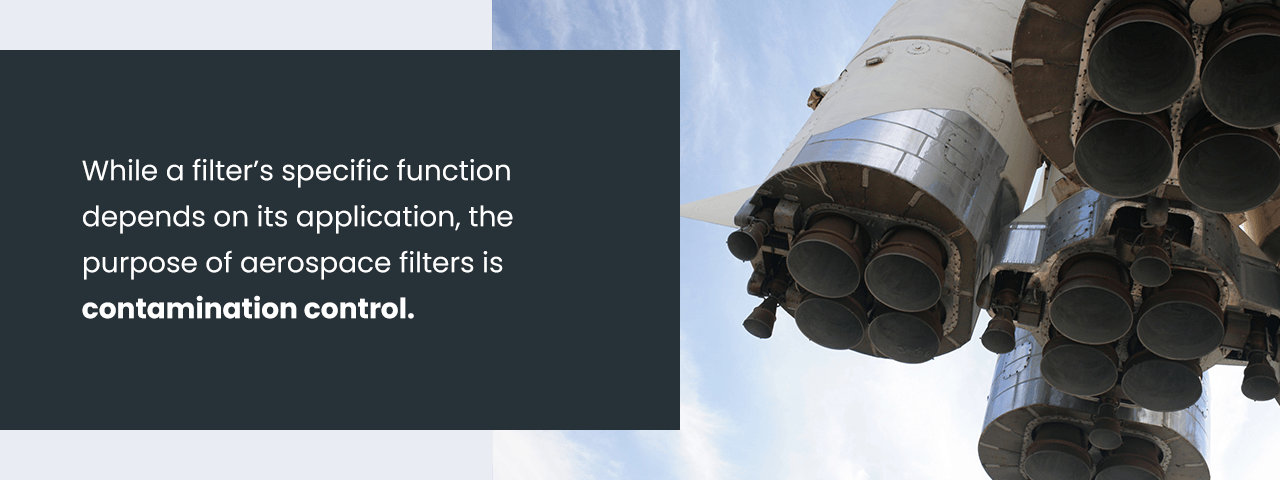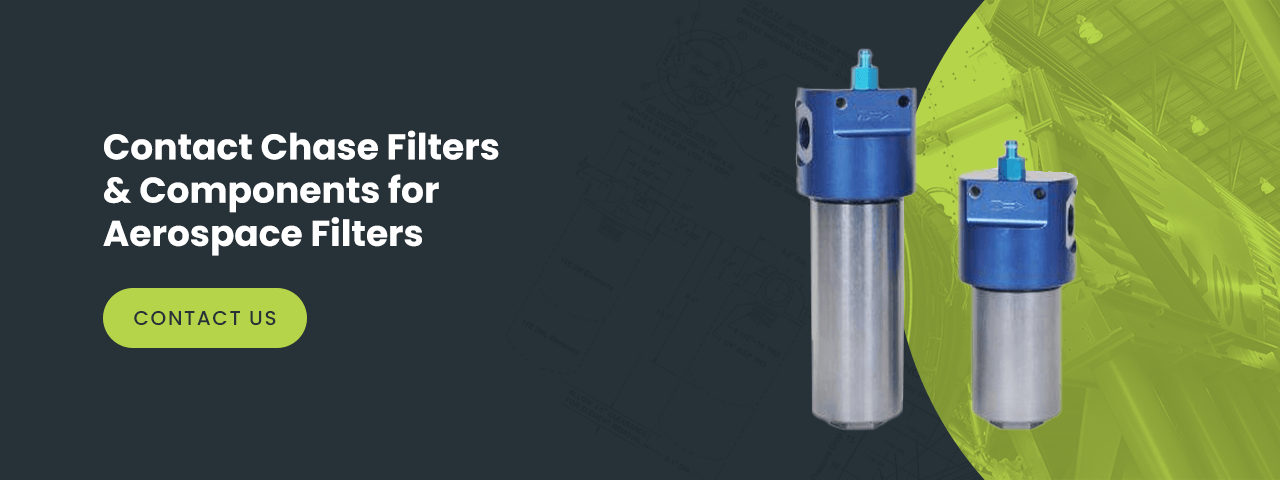January 19, 2024
Guide to Aerospace Filters

Jump To:
- What Are Aerospace Filters?
- What Is the Application of Aerospace Filters?
- What Is the Function of Aerospace Filters?
- What Are the Quality Standards for Aerospace Filters?
- What Are Common Filter Ratings?
- What Is the Beta Ratio?
- Benefits of Aerospace Filters
Aircraft and spacecraft need quality filters to operate efficiently. Aerospace filters keep the systems healthy and prevent unexpected failures. They make it possible to fly long distances without disruptive stops for repairs. Aerospace filters make your aircraft and spacecraft safer.
We’ve put together this comprehensive guide to aerospace filters to help you learn more. We’ll discuss what they are, their functions and applications, various quality standards and ratings and the benefits of using quality aerospace filters.
What Are Aerospace Filters?
Aerospace filters remove contaminants from fluids to help equipment and components perform efficiently and prevent system failures. The aerospace system uses multiple types of filters, each with a unique application and function.
What Is the Application of Aerospace Filters?
Aerospace filters have various applications. Typical types include:
- Hydraulic filters: Aircraft use hydraulic systems to move and actuate equipment like landing gear, brakes and flaps. Hydraulic filters force hydraulic fluid through a filter element, which catches damaging particulates such as dirt, sand, sludge, oxidation, chemical byproducts, elastomeric seals and metal. Ideally, the filters are located before or after the pumps, within the reservoir or in the return lines.
- Breathing filters: Airplane filtration systems rely on air filters to clean the air of contaminants and allergens, ensuring the air in the cabin is comfortable and safe. High-Efficiency Particulate Air (HEPA) filters used in aircraft are capable of removing up to 99.97% of contaminants.
- Fuel filters: Aircraft rely on quality fuel for efficient functions and general maintenance. Fuel filters ensure the engine receives clean fuel, minimizing the wear on pumps and injectors.
- Coolant filters: Coolants help in temperature regulation and should preferably have high thermal conductivity and low viscosity. Coolant filters remove the contaminants which would otherwise affect the coolant’s proper functioning.
- Water filters: Aircraft use different types of water filters to keep the water clean. For example, carbon filters neutralize chlorine in the water. Other types address odor and taste, turbidity and scale buildup.
- Oil filters: In aviation, oil filters help supply clean, quality oil to vital parts of the engine. They remove dirt and damaging particulates and increase the engine’s life span and overall efficiency.
- Pneumatic filters: These filters remove contaminants from compressed air and protect the pneumatic devices from damage. Common contaminants include water droplets, dirt particles and aerosols.
- Oxygen filters: Oxygen filters trap aerospace system contaminants and prevent them from damaging components and equipment, maintaining an efficient oxygen system. They provide quality air to the cabin in aircraft and spacecraft, along with many other applications.
What Is the Function of Aerospace Filters?
While a filter’s specific function depends on its application, the purpose of aerospace filters is contamination control. They remove damaging particulate from fluids, preventing damage and helping systems run at peak efficiency. Filters also increase the equipment and components’ life span.
What Are the Quality Standards for Aerospace Filters?
The International Organization for Standardization (ISO) has standards for all aerospace filters and standards specific to coalescing filters. Let’s consider each category:
General ISO Standards for Filters
The general ISO standards for filters include:
- ISO 2941, which specifies a method for the verification of collapse and burst resistance.
- ISO 2942, which defines a test method to verify the fabrication and integrity of a filter element.
- ISO 2948, which provides for material compatibility with fluids.
- ISO 3724, which specifies a method to determine a hydraulic filter element’s resistance to flow fatigue.
- ISO 3968, which specifies a procedure for evaluating differential pressure drop versus flow rate.
- ISO 16889, which describes multi-pass performance testing.
- ISO 14085, which sets the standard for the aerospace series.
ISO Standards for Coalescing Filters
The ISO standards specific to coalescing filters are:
- ISO 8573-1:2010, which specifies the amount of contamination allowable in each cubic meter of compressed air
- ISO 8573-2:2007, which specifies the test method for oil aerosol content.
- ISO 8573-3:1999, which provides guidance and test method for the measurement of humidity.
- ISO 8573-4:2001, which defines the test method for solid particle count.
- ISO 8573-5:2001, which specifies the test method for oil vapor and organic solvent content.
- ISO 8573-6:2003, which provides suitable test methods for gaseous contaminant content.
- ISO 8573-7:2003, which specifies the test method for viable microbiological contaminant count.
- ISO 8573-8:2004, which specifies the test method for solid particle count by mass concentration.
- ISO 8573-9:2004, which specifies the test method for liquid water content.
What Are Common Filter Ratings?
The two typical filter ratings are nominal and absolute:
- Absolute rating: Also known as the cut-off point rating, the absolute rating measures the diameter of the largest particle that can pass through the filter under non-pulsating low-pressure conditions. The absolute rating considers the medium’s pore opening size.
- Nominal rating: A filter’s nominal rating measures its filtration degree according to the percentage of particles it prevents from entering. This method is least recommended because different factors may affect the results, making it inconsistent.
What Is the Beta Ratio?
The beta ratio is a recently developed and widely accepted test method. It determines the filter’s efficiency level depending on its ability to remove contaminants. It’s measured by dividing the number of particles of a given size before filtration by the number of particles of the same size after filtration. The higher the ratio, the higher the filter’s capture efficiency. You can calculate it using an ISO multi-pass test standard 16889:2008.
The beta ratio helps you choose the appropriate filter and measures the functionality of the fluid system. In the end, you’re able to mitigate mechanical breakdown.
4 Key Benefits of Aerospace Filters
The various types of filters have different benefits. Generally, aerospace filters make the system reliable, increase its life span, improve performance and maintain clean fluid flow. Let’s consider each benefit in more detail:
1. Maintain Clean Fluid
Aerospace filters ensure that clean fluids pass through the various components of the air- or spacecraft. Removing contaminants keeps the systems performing at their peak level and prevents system failures. When the fluid is clean, operation and maintenance are easier and usage is safer, convenient and reliable.
2. Improve Reliability
The aerospace industry requires reliable components and equipment to operate. Filters ensure that the various systems can perform at the optimum level. Using a reliable system also improves the safety of the pilots, crew and passengers and makes the cabin more comfortable.
3. Increase System Life Span
Aerospace filters reduce damage and increase the system’s life span. They capture contaminants such as dirt, sand, metals and chemical byproducts, improving the system’s usage time and performance. Using quality filters is a long-term maintenance step that translates into high investment returns.
4. Improve Performance
Aerospace filters improve the efficiency of a system’s various components by ensuring that only clean fluids pass through the units. Apart from increasing performance, the filters offer consistency in the filtration process.
Contact Chase Filters & Components for Aerospace Filters
By maintaining the quality of necessary fluids, aerospace filters serve an essential function in making aircraft and spacecraft work more efficiently and increasing their life span. These filters have several benefits, from removing contaminants from fluids to making air- and spacecraft work more efficiently to increasing their life span. They ensure that only clean fluid runs through the system, improve reliability, increase system life span and ensure better and consistent performance.
Chase Filters & Components is the leading manufacturer of filters for major industries, including the aerospace, defense, automotive and oil and gas industries. Our range of aerospace filters includes the 25 series, the 31 series and the 51 series. We have experience in professions with in-depth knowledge of each sector we produce for. Do you want to learn more about our products and services? Contact us today!

